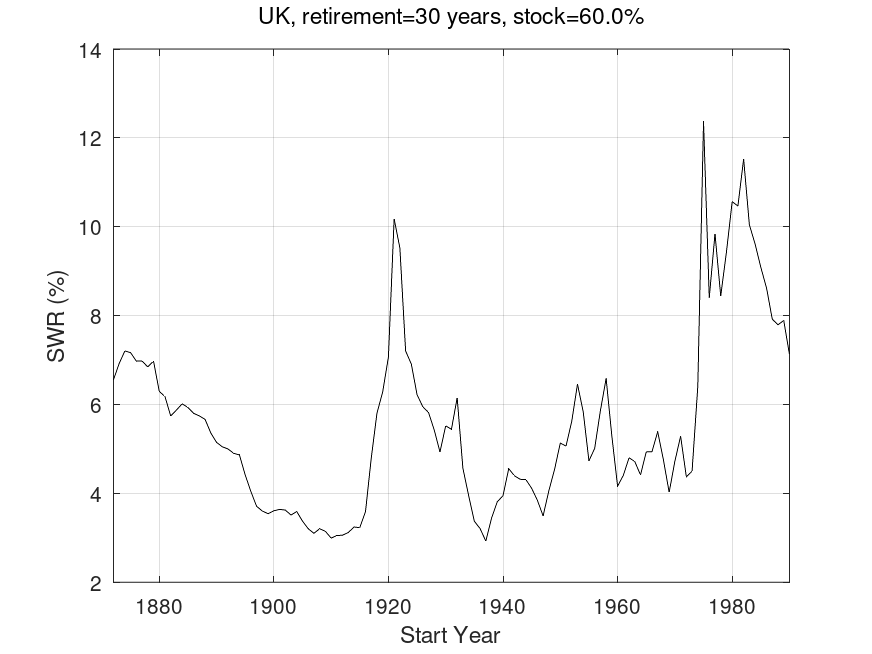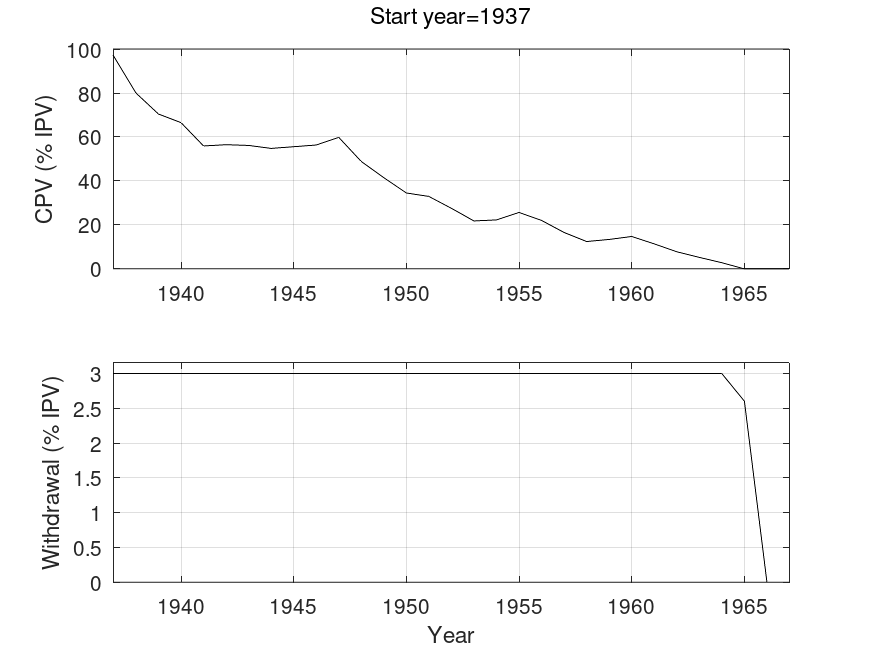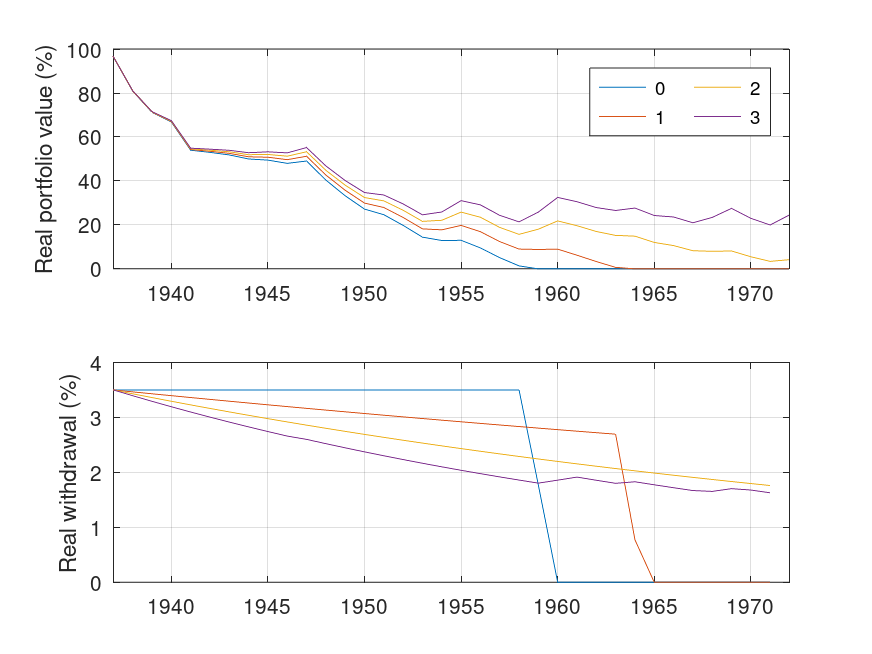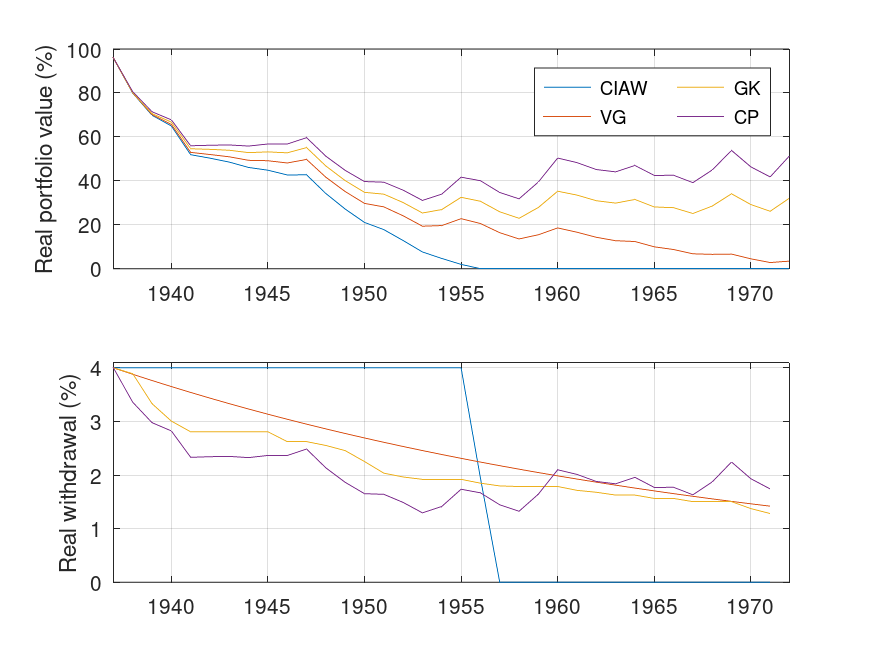We’d like to remind Forumites to please avoid political debate on the Forum.
This is to keep it a safe and useful space for MoneySaving discussions. Threads that are – or become – political in nature may be removed in line with the Forum’s rules. Thank you for your understanding.
📨 Have you signed up to the Forum's new Email Digest yet? Get a selection of trending threads sent straight to your inbox daily, weekly or monthly!
The 4% rule
Comments
-
In line with what others have said, the 4% 'rule' was derived from historical data for a 30 year retirement by a US retiree where a constant, inflation adjusted, withdrawal was made each year. While there are various definitions, the SAFEMAX is the highest withdrawal, expressed as a percentage of the initial portfolio value, that could have been withdrawn (note tense) historically.aroominyork said:My understanding of the 4% rule is that an inflation adjusted 4% withdrawal each year should – with a 60/40 equity/bond portfolio? – last 30 years. Is that correct?
Does anyone know of an open source spreadsheet where you can enter different rates of investment return/inflation/withdrawals to test scenarios?
For a UK retiree, the SWR as a function of the start year for 30 year rolling periods is given in the following graph (60% equities, 40% long gilts, inflation and asset returns from the database at macrohistory.net)
The SAFEMAX (i.e. the lowest value on the graph) of about 2.9% corresponds to a start year of 1937 (just before a major stock market drop, followed by WWII and then a long period of awful performance for UK gilts), while there is a long period in the run up to WWI with low SWR values. It is useful to note that at times the SWR varied rapidly with start date.
While the SWR from constant inflation adjusted withdrawals provides a reasonable starting point for planning purposes it would be an awful approach to actually adopt for a number of reasons.
1) The historical value of SAFEMAX varies with the exact database of returns and inflation (e.g., there are at least 4 different inflation series for the UK before 1948) used. Changing the inflation series can change SAFEMAX by more than 20 bp, while changing bond duration leads to changes of up to 40 bp. In other words, past values are not all that precise.
2) The future value of SAFEMAX is unknown and unknowable. The method is therefore not robust to future market and inflation conditions.
3) There are historical retirements, where psychologically it would have been very difficult for the retiree to continue taking constant inflation adjusted withdrawals through the whole period because of poor conditions early on in the retirement. An example is shown in the following figure (the upper panel shows the real portfolio value and lower panel the real withdrawal rate as a function of time for a 3% withdrawal rate). In this example, after 4 years the retiree has seen their portfolio drop by over 40% in real terms, after 15 years (i.e., only half way through the planned 30 year period) in real terms it is down to 20% of its original value. At that stage, the retiree would be withdrawing about 14% of the remaining portfolio each year and would probably be a bit worried. Historically, things turned out just about OK (there was a shortfall in the last couple of years), but this would not have been known in 1953.
To obliquely answer your second question, there is a useful, but somewhat limited, calculator using historical UK data at https://www.2020financial.co.uk/pension-drawdown-calculator/
5 -
While I agree that flexibility is key, strictly speaking the 'safe' withdrawal rate only corresponds to the method of constant inflation adjusted withdrawals.tacpot12 said:For most pensioners in the UK, I would argue that a Safe Withdrawal Rate is above 4%. The state pension entitlement that most people will have means that much of their essential spending is covered by the state pension. This means that they only need their discretionary spending to be covered by withdrawals from their personal pensions. This gives much greater flexibility to adjust your savings when the stock market isn't doing well.
An example of the effect of different amounts of portfolio flexibility can be found in the following figure (this uses the vanguard dynamic withdrawal method, https://www.vanguardinvestor.co.uk/articles/latest-thoughts/retirement/flexible-approach-support-retirees-good-bad-times) where different levels of flexibility ranging from 0, constant inflation adjusted withdrawals to 3 (a change, in real terms, of up to 3% of the previous withdrawal is allowed) with an initial withdrawal of 3.5%.
With zero flexibility, the income is (not surprisingly) constant right up to the point where the portfolio is exhausted (about 20 years after retirement) when it falls to zero. By way of contrast, with '3% flexibility' the portfolio survives for over 35 years but towards the end, the income is about half that at the beginning. The impact on overall income will depend on the relative sizes of guaranteed income derived from the state pension (and DB pensions and RPI annuities) and the income from the portfolio.
In terms of portfolio survival, it is clear that adopting some flexibility (e.g., '1%') extends portfolio life, but it can still become exhausted eventually. Essentially, it is a tradeoff between portfolio longevity and income volatility.
0 -
How does this Vanguard flexible approach/dynamic spending differ from the Guyton Klinger approach, which was often mentioned on this forum in the past by a now quiet poster.
On the surface at least they seem a very similar idea.0 -
Yes, more recently I have been considering how other countries see SWR. Just because the UK and US have provided good returns on both equities and bonds, plus moderate inflation and strong currencies, why shouldn't we consider what has happened in other countries. Could the US not be another Japan? Is it impossible to imagine the UK going through the same difficulties of 1970's Spain?masonic said:That's the conclusion drawn from historical data for someone living in the USA.There are various sites that allow you to test alternative assets and get local interpretations. The latest being portfoliocharts.comThere is also portfoliovisualizer.com for deeper analysis.
Interesting calculator
Global Withdrawal Rates – Portfolio Charts1 -
Operationally, IMO, the vanguard method is much more straightforward.Albermarle said:How does this Vanguard flexible approach/dynamic spending differ from the Guyton Klinger approach, which was often mentioned on this forum in the past by a now quiet poster.
On the surface at least they seem a very similar idea.
Functionally, they, like a lot of hybrid* methods, give similar-ish results (although it depends on how much you customise the various parameters).
* i.e., some mix of percentage of portfolio and inflation adjusted withdrawals
0 -
An example just to illustrate the difference in output where CIAW=constant inflation adjusted withdrawals (i.e., SWR), VG=vanguard dynamic, GK=Guyton Klinger, and CP=constant percentage of portfolioAlbermarle said:How does this Vanguard flexible approach/dynamic spending differ from the Guyton Klinger approach, which was often mentioned on this forum in the past by a now quiet poster.
On the surface at least they seem a very similar idea.
In this example, CIAW has the sudden drop in income when the portfolio runs out (an initial withdrawal of 4% is well above the 'safe' value for this historical case). The income using CP is very variable from year to year and across the retirement, but income does recover towards the end of the retirement after minima in the 1950s. VG has a smooth drop in income (3% per year which is what I've used as a maximum change in real income) but continues to decline throughout the whole retirement and, after 35 years, doesn't leave a lot in the portfolio (another couple of years might see portfolio exhaustion). The income from GK drops significantly over the first part of the retirement (but not as much as CP) although the gradient is less steep towards the end. GK leaves somewhat more in the portfolio after 35 years than VG, but at the expense of a larger drop in income towards the beginning of retirement.
I think the point is that if the volatility in income of a percentage of portfolio method is too much (there are good reasons not to use a constant percentage, but that's a different story) and the risk of portfolio exhaustion is too awful to contemplate, then a hybrid method (of which GK and Vanguard are only two examples of many) forms a half way house - the volatility is reduced compared to percentage of portfolio methods, and the risk of portfolio exhaustion is reduced compared to inflation adjusted withdrawal methods. However, there is no perfect withdrawal method.
IMO, building a floor using SP, DB pension, annuities or inflation linked ladders such that volatility in the income from the portfolio becomes less important is a more robust approach.
1 -
You've misunderstood what the 4% rule study is saying. It just provides the probability that an amount of money will last a certain number of years given various asset allocations and withdrawal rates and inflation rates. Using US historical investment data a 4% plus inflation withdrawal from a 60:40 asset allocation gives a better than 95% probability of lasting for 30 years...or something like that. It does not address the absolute amount of money needed in retirement, for that you need to include a budget and other sources of income. If a large portion of a retiree's spending is covered by state pension then they could well require less than 4%, but any withdrawals above 4% will increase the probability that you run out of DC pension money before you die. In the UK that SWR percentage might be 3%. Some studies have shown that variable withdrawal strategies might be more useful to many retirees.tacpot12 said:For most pensioners in the UK, I would argue that a Safe Withdrawal Rate is above 4%. The state pension entitlement that most people will have means that much of their essential spending is covered by the state pension. This means that they only need their discretionary spending to be covered by withdrawals from their personal pensions. This gives much greater flexibility to adjust your savings when the stock market isn't doing well.
It's also to be noted that the UK state pension replaces a lower percentage of pre-retirement income than most developed countries.And so we beat on, boats against the current, borne back ceaselessly into the past.2
Confirm your email address to Create Threads and Reply

Categories
- All Categories
- 351.8K Banking & Borrowing
- 253.4K Reduce Debt & Boost Income
- 454K Spending & Discounts
- 244.8K Work, Benefits & Business
- 600.2K Mortgages, Homes & Bills
- 177.3K Life & Family
- 258.5K Travel & Transport
- 1.5M Hobbies & Leisure
- 16.2K Discuss & Feedback
- 37.6K Read-Only Boards


